How to Download a Full Size MacOS Mojave Installer

Did you go to download macOS Mojave but found an incomplete installer application arrived in your /Applications folder? Some Mac users have discovered that when trying to download macOS Mojave from the Mac App Store, they end up with a very small 22 MB mini-installer that is not the full size 6 GB macOS Mojave installer app.
While the regular update or installation for macOS Mojave works just fine from the 22 MB stub installer (the other install files are downloaded later), you can’t use the 22mb incomplete installer to make a bootable macOS Mojave installer flash drive, nor use the mini-installer offline, and also since it’s not the full installer app it makes little sense to copy it to other Macs if you want to install Mojave onto them too.
This article will show you two different methods and tricks for how to download the proper complete macOS Mojave installer application if you ended up with the small 23 MB version of “Install macOS Mojave.app” rather than the full sized one.
Note most Mac users will NOT need to follow these instructions. For the majority of users, simply downloading MacOS Mojave from the Mac App Store directly will get them the full 5.8 GB installer application onto their Mac. Thus this guide is only for users who have found the incomplete 22mb installer app in their /Applications/ folder, and who want the full size version so that they can make a boot USB drive or whatever else. You can use either the dosdude1 application approach, or further below you’ll find how to build your own full macOS Mojave installer manually yourself by using the Terminal. The end result is the same, whichever approach you use.
How to Download the Full MacOS Mojave Installer File
- Go here to dosdude Mojave page and download the patch tool (the download links are labeled as “Direct” and “Mirror” on that page) *
- Launch the Mojave patch app (you may need to bypass the Gatekeeper warning by right-clicking on the app and choosing “Open”)
- Pull down the “Tools” menu and choose “Download macOS Mojave”
- Confirm that you want to download the full 6.5 GB MacOS Mojave installer, then choose a Save destination for it (if you plan on making a USB installer, putting it into the /Applications/ folder is necessary)
- Wait for the entire download to complete, it will be multiple parts that the Dosdude tool builds into the single proper installer
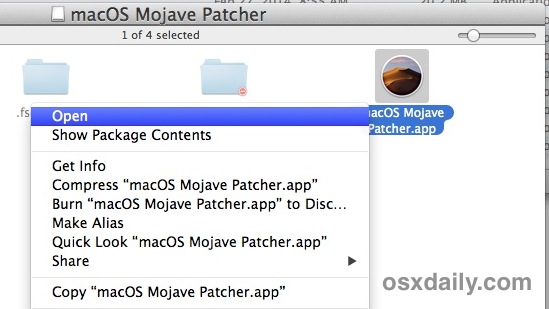
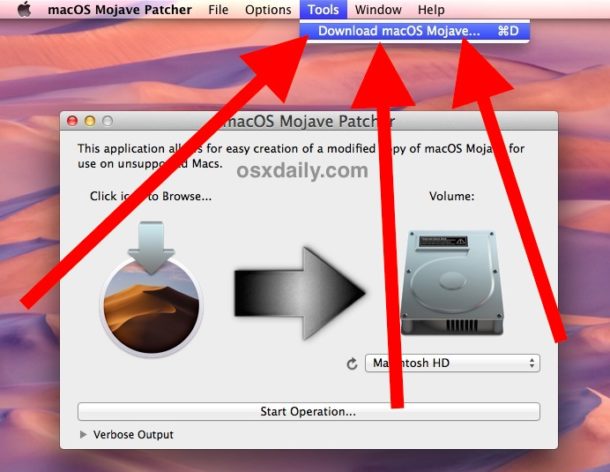
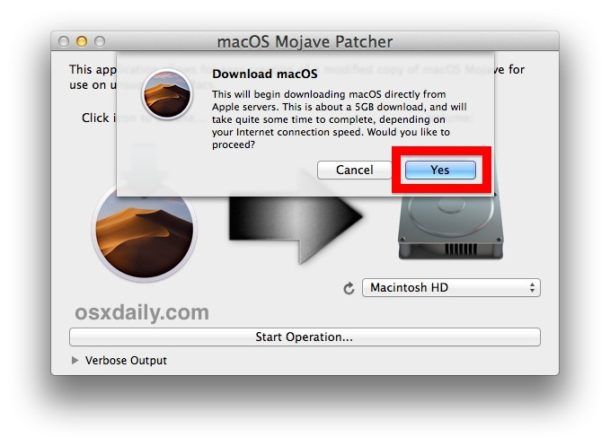
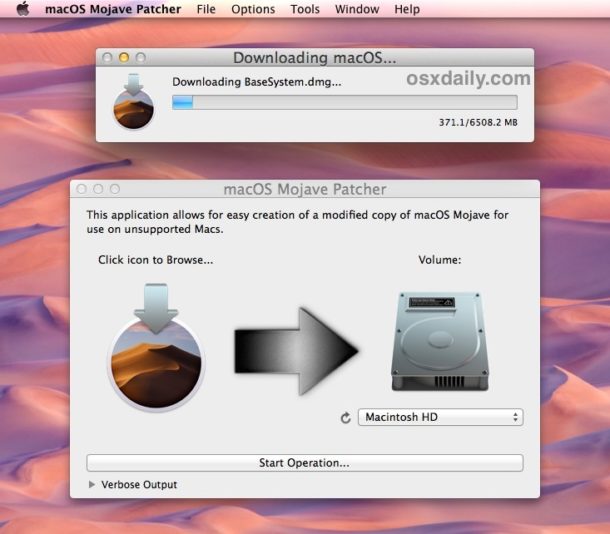
When complete, look in the directory you chose as the Save location for the “Install MacOS Mojave.app” file, you can confirm it is full size by selecting it and choosing Get Info if desired.

From the Get Info window on the installer file, here’s the mini 20 MB “stub” installer for macOS Mojave that is incomplete:

Also from a Get Info window on the full size installer application downloaded via DosDude tool, here’s the complete XXX GB “Install macOS Mojave.app” installer app:
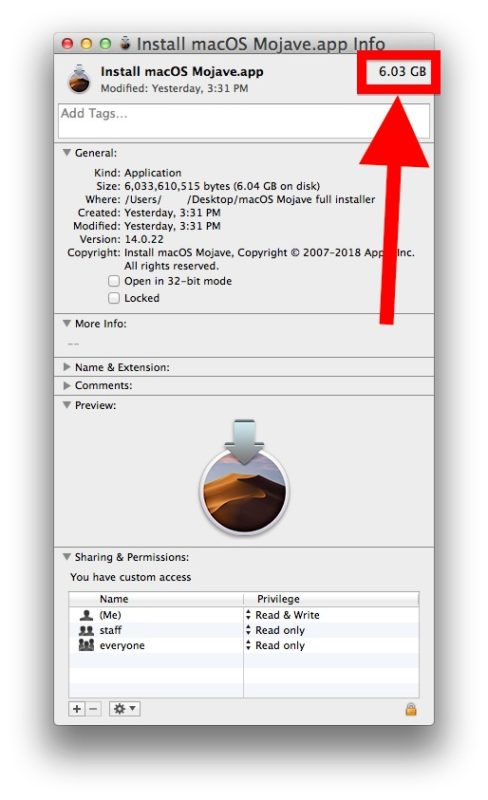
The latter complete installer file is the only one that contains the createinstallmedia tool to be able to build a macOS Mojave boot disk as discussed here.
* In case you were wondering what this patch is intended for, the Dosdude Mojave patch allows you to install macOS Mojave on unsupported Mac hardware in an unofficial capacity, but that is not what we’re aiming to do here. For our purposes in this particular walkthrough well simply use the patch to download the full installer app. If installing macOS Mojave on an unsupported Mac interests you, you can read more here or on the aforementioned DosDude page.
I went through this exact process on a MacBook Air running Mac OS X Mavericks 10.9.5 and it worked exactly as described to download the full size macOS Mojave 10.14.x installer application.
For what it’s worth, a similar mini-installer issue occurred previously with some users getting a tiny incomplete macOS High Sierra installer too and we covered a similar workaround here to download the full installer file for macOS 10.13.x.
It’s not entirely clear what causes the small installer app to download on some Macs but not others, it may be related to the exact version of Mac OS / Mac OS X system software installed on the Mac which is attempting the download, or perhaps on available hard disk space. This is only speculation however, and if you have an exact answer (or theory) as to why some Mac users download the full Mojave installer and some download the mini-installer, share with us in the comments below.
Alternate Method: How to Manually Build a Full MacOS Mojave Installer
Another approach allows you to manually build your own full macOS Mojave installer, without using the Dosdude tool discussed above. This method works to create a full 6GB “Install macOS Mojave.app” installer application which can be used for making USB boot disks and independent installations.
This approach is a fantastic tip that was left in our comments here by Randy (thanks Randy!), it has been repeated below with minor editing for clarification:
How to build your own full macOS Mojave installer-
To get the full “legit” version [of Install macOS Mojave.app] from Apple, start the mini installer that you get from the App Store and follow the prompts until you get to the point that it starts counting down to reboot your machine. Quickly CANCEL the reboot.
Once you cancel, you will have the full 6gb installer files since the mini installer downloads all required files. It will create a folder titled “macOS install Data” on the root of your primary hard drive.
Once you have all of the files, you now have to make the installer package by running the following 3 commands in Terminal:
At the command line, first type the following for super user privileges:
sudo -sEnter your password then type the following 3 commands followed by return after each command:
mkdir /Applications/Install\ macOS\ Mojave.app/Contents/SharedSupport
cd /macOS\ Install\ Data
find . -mount | cpio -pvdm /Applications/Install\ macOS\ Mojave.app/Contents/SharedSupportAfter you’ve followed those steps, right click the installer that you originally downloaded from the App Store in your Applications directory and you’ll see that its now 6GB instead of the 23mb or 25mb that you get from the App store.
Let us know in the comments below which method you used to get a full MacOS Mojave installer application.


Loving the guide but running into an issue when I go to patch Mojave to the USB.
“FAILED:
Mounting failed. Please check your macOS Mojave Installer App, then run the tool again.”
I’ve tried a few different older patch versions with the same issue. And I’ve also re-downloaded Mojave through the app store.
Any ideas?
Thanks so much
L
I used the alternative method : it was simple and effective. Thanks !
I tried making a USB Mojave installer following all the guidelines, put it in my 2019 Mac that shipped with Mojave and the install stalls at about 1/3rd across the progress bar for just over 2-1/2 hours now. So I think _something_ is corrupt. I followed the link above on my older mac and tried to download Mojave from the App store, and I’m told I can’t because _this_ El Capitan Mac can’t run Mojave. When I tried to do the same with the new mac (running ugh… catalina) it said it would only run Catalina so it wouldn’t let me DL Mojave. Is there another workaround that could be used? Is there a way to check a USB installer to know that its not corrupted?
In this link there’s a full guide to create a boot disk to install macOS that I found really easy.
https://support.apple.com/en-us/HT201372
Where is the steps to build a bootable Mojave installer for those of us whose Mac drive is dead? We can’t utilize Mac utilities, iTunes or the App Store. How can we get a working bootable ISO to reinstall Mojave? I downloaded this one but after booting holding C and getting to the installer menu it says it’s not valid or is corrupt and won’t use it.
If your Mac drive is dead you would need to use another computer to create a boot drive to reinstall MacOS, and probably replace the dead drive with a new one too
this link works well:
https://itunes.apple.com/us/app/macos-mojave/id1398502828?mt=12
Wow, totally absurd. You can’t locate the installer by searching, yet this link DOES turn it up. Thanks for sharing!
https://itunes.apple.com/us/app/macos-mojave/id1398502828?mt=12
Bravo, You nailed it, instead of lengthy procedure, this links works and a lot of hours saved.
Thanks bro! Steve Woo
I think the second method is fantastic as it uses all Apple downloads and Terminal and not a patcher from an unknown source. To be fair the patcher did have 0/53 on VirusTotal : https://www.virustotal.com/gui/file/42cf282c613a298d9a2da1a0f1ff6f4d81cd079d637b19f371cccd7198049b2a/detection, but I prefer the DIY method.
Some notes that should help people:
1. You need to add -p to the mkdir command to create multiple nested directories or you’ll get an error:
mkdir -p /Applications/Install\ macOS\ Mojave.app/Contents/SharedSupport
2. You need to change permissions on the original 22.8 MB stub app, ‘Install macOS Mojave.app’, which should be in the /Applications folder, so it can be written to:
chmod -R 755 /Applications/Install\ macOS\ Mojave.app
Then follow the directions and get a 6.05 GB full installer.
I did this in a Fusion VM of Mojave so there was no chance of accidentally letting the installer restart and ruin my real installation. You have to watch it as it gets close to the restart countdown, then just quit the installer.
The notes are odd:
1. /Applications/’Install macOS Mojave.app’/Contents
is part of the mini-installer, so -p is not needed.
2. /Applications/’Install macOS Mojave.app’ is already 755 as downloaded normally, so chmod is not needed.
I was able to download the app from the app store and followed the second set of directions. It did in fact create the 6.03GB app in the apps folder. But, the icon for the app shows a large overlay with a diagonal bar through it. Why?
My next question is now that I have the app, how do I make it bootable for putting on a recovery CDRom?
And finally, how do I delete the folder that was created on the root of my disk? I cannot delete it because it says it is needed by the installation.
Your courteous response is greatly appreciated!
Thanks,
-DON-
The icon is like that since your mac can’t read the installer. The newer OS is installed using a different format so that is why you need to use a USB or CD/DVD to boot first to install. I use an app called unetbootin. You can get it here: https://unetbootin.github.io/
works great. Hopes this helps
emmm… I found that in the Mojave.app(22 MiB)/Contents/Resources/startosinstall is the main download file, so we can use this file to download the full packages.
command line:
/startosinstall –rebootdelay 300 –agreetolicense
then wait for the download finished, press -C, we can use the dalao’s command to build the full package.
i followed the second method but the installer is still 20 megabytes
I downloaded the Mojave installer but instead of it downloading the app, it downloaded the files. I then got a mac >2012 which could download Mojave but it downloaded the 22mb app only.
I then tried the steps outlined by Randy, but at the command;
cd /macOS\ Install\ Data
it says folder not found, and when I go to the next command, it puts everything on my mac into the sharedsupport folder.
I will greatly appreciate all the help I can get.
I am running a 2011 Macbook Air
I have the Mojave installer in my App folder and I know I didn’t click on anything to install it. I don’t know how it got there. And it’s the 6GB version. Might it have been preinstalled??? (it’s a fairly new iMac)
I keep getting an error message when I try to download mojave. “An error occurred while downloading macOS. Please check your Internet connection and try again.”
I used the 2nd method – start the small installer and cancel when the reboot timer starts.
On my personal laptop, I could only get the small <25MB installer file.
I have a mid 2014 13" MacBook Pro
core i5 running El Capitan 10.11.6
roughly 65GB free disk space of 500 total
So I followed the directions for:
Alternate Method: How to Manually Build a Full MacOS Mojave Installer
Once done, I followed the usual steps from Apple's support page:
https://support.apple.com/en-us/HT201372
sudo /Applications/Install\ macOS\ Mojave.app/Contents/Resources/createinstallmedia –volume /Volumes/MyUSBdriveHERE
Where MyUSBdriveHERE is the name of the partition on a USB drive I wanted to make bootable.
I thought it odd that this was the first time I've run into the small Mojave installer.
With computers at my work, I've updated at least a dozen machines to Mojave (though usually not straight from El Capitan), and as far as I can tell it usually gets the full installer file.
I've even created and updated my Mojave USB installer several times in the past couple months. I did always download it from a 2018 MacBook Pro or Air, already running Mojave.
Maybe that makes a difference, dunno why really.
Anyway, after running the commands above, I can now see my 10.4.4 Mojave installer as a bootable option in startup disk preferences.
I will test booting from it tomorrow (it's late), and after all this – I plan to create a bootable clone to external SSD before I actually run the Mojave update.
Whew.
The install worked great, however, I put it on a partition of an external HD. When I restarted from the Mojave Desktop (Startup), I selected the original 10.9.5. When I got to the desktop and then back into Startup, it’s not there. And I don’t see the Mojave icon on the desktop too. But I do the other icons for the other versions from Yosemite to High Sierra. What happened?
Connect the drives to the Mac that have the operating systems you want to boot from
Reboot and immediately hold down the OPTION key to access Startup Manager
Select the boot OS from startup manager
That should do the trick.
Worked like a charm. Been trying to get a proper installer set up for some time now and I’m running into small problems on just about every step.
Sorry, if i use this patch will i still be able to update softwares directly from the app store?
Thank you. I inherited a 2015 MacBookPro that wouldn’t boot, replaced the SSD. Mac wouldn’t recognize the SSD, Ubuntu Live would and let me install Ubuntu but Mac hardware/firmware configs wouldn’t recognize the SSD no matter how I formatted it. Recovery wouldn’t work. I have to assume this Mac never saw High Seira and whatever file system firmware changes occurred then that prevented it from seeing the 480GB OWC Aura Pro X SSD.
This article was the only way I found to get the full installer – App Store would only deliver an update.
I had to use: sudo /Applications/Install\ macOS\ Mojave.app/Contents/Resources/createinstallmedia –volume /Volumes/Untitled
To get it to start installing. Not really sure what was different about this but copied from https://support.apple.com/en-us/HT201372
Guessing that this page might have had some none viewable chars in the command provided.
In short, it was a long process to get to understanding that a new SSD won’t be recognized by a Mac and then to detangle from multiple sources how to ‘fix’ it and load some OS.
Jack
TIP: I usually install the OS before installing the SSD drive into the mac.
I used the patch method on my mid-2014 MacBook Pro, running OS 10.9.5 and the patch worked perfectly. The short version may have more to do with the model of the computer rather than the operating system on it.
I used the patch method on my mid-2014 MacBook Pro, running OS 10.9.5 and the patch worked perfectly. The short version may have more to do with the model of the computer rather than the operating system on it.
When I try to download MacOs Mojave in the patch app, the downloaded install app is “Mac OS High Sierra” and hence the creation of a bootable mojave disk will of course not work. Not sure what happened, but I solved through method number 2, so for those of you in my situation – go with the alternate method which worked like a charm.
I have a MacBook Pro (Retina, 15 inch, mid 2014) with Yosemite 10.10.5.
The patch installer does not work for me since I have a supported Mac. Upon opening it I get a message stating I do not need to use it but can use it to create a USB install disk. If I go and click on the 22MB partial install app that’s on my MAC it simply returns an error message stating that’s not a correct file type. So much for this utility.
Here is how I did it:
1) “mac os mojave mac appstore”
2) When the “Software Update” window opens click on “Advanced…” (bottom right)
3) Uncheck “Install macOS updates” (type password)
4) Wait until installer pops up
5) ???
6) Profit.
To get the full “legit” version from Apple, start the mini installer that you get from the app store and follow the prompts until you get to the point that it starts counting down to reboot your machine. Quickly CANCEL the reboot. Once you cancel, you will have the full 6gb installer files since the mini installer downloads all required files. It will create a folder titled “macOS install Data” on the root of your primary hard drive.
Once you have all of the files, you now have to make the installer package by running the following 3 commands in Terminal:
Type sudo -s
Enter your password then type the following 3 commands followed by return after each command:
mkdir /Applications/Install\ macOS\ Mojave.app/Contents/SharedSupport
cd /macOS\ Install\ Data
find . -mount | cpio -pvdm /Applications/Install\ macOS\ Mojave.app/Contents/SharedSupport
After you’ve followed those steps, right click the installer that you originally downloaded from the App Store in your Applications directory and you’ll see that its now 6GB instead of the 23 or 25mb that you get from the App store.
Randy, this is a fantastic tip to build your own full MacOS Mojave installer, thank you for sharing this!
my pleasure, Paul! I somehow fat fingered that last command. Instead of “clio” its cpio
My apologies
Randy, everything’s fine until the last command. I get a “bash: clio: command not found” error. I’m using Yosemite 10.10.5 .
So sorry Hm.. I fat fingered that last instruction. Instead of “clio” its cpio
Please let me know if it works
@Hm
I believe there is a typo in the commands above, here is what may work:
Note the ‘clio’ is actually ‘cpio’ I could be wrong, but cpio is an archive utility so it would make sense that it’s being used here.
Hi there Astute,
when I type the commands;
cd /macOS\ Install\ Data
I get a directory not found error, which makes me not able to finish the command prompt that follow.
Also when I download the installer using the program, it says,”An error occurred while preparing the macOS Installer app”.
HELP
After Typing in Terminal
bash-3.2# find . -mount | cpio -pvdm /Applications/Install\ macOS\ Mojave.app/Contents/SharedSupport
I am getting this error
/Applications/Install macOS Mojave.app/Contents/SharedSupport/./Locked Files/cleanup_installer
cpio: Failed to set file flags
Please help!!!
This does not work properly, even if you created a bootable installer, it will always connect to apples servers to download the latest version of mojave. so, eventually its not a full installer. Just a bootable drive. Test it by booting from USB and then turn off internet while trying to install Mojave Any idea how to stop that?
Thanks for this tip! Haven’t upgraded my macbook pro for 6 years but it meets the update criteria. Cannot get the mojave update via the app store – app store won’t let me set up an apple ID, very weird. Can I used the downloader from http://dosdude1.com/mojave/ to update to mojave … even though my computer is “new enough”? Thanks in advance.
You can skip the 130 mb tool download by downloading the creators separate tool, specifically for downloading macOS versions: http://dosdude1.com/apps/macOS%20Downloader.zip
Does this download a patched version or the full version from Apple?
I when I connect to download, through the SW update facility, on more than 1 machine, with different operating systems. I get 22Meg issue .
If I “duck duck go” or similar, download M. I get 5 + G.
Apple and Micro$oft are both pushing ID before download new sw, download install only, with no offline installers, and compulsory auto updates with auto spying, for a reason .
That reason is not good for joe average user.
APPLE is slow becoming, what Micro$oft became, a long while ago.
To see this look at the carnage they have wrought on OSX since Mountain Lion.
Even disk utility has become toothless tiger, in Recovery Mode since at least High Sierra, you can not even bring up Terminal easdily in disk utility.
The update to Mojave has lessened a bit. It now is tad smaller at 6.01GB rather than 6.03 GB.
When trying to download the full installer, dosdude’s patcher fails with error message “Could not locate the correct entry in the CatalogURL. Cannot continue.”
I got this too and so far haven’t seen anyone else with this message, I’m hoping someone can help.
Figured out my problem: I can’t read instructions lol. I tried “Click the icon to browse…” to add the 22mb file when I should have (end eventually did) go to “Tools>Download Mojav”. It pays to read all of the instructions. lol.
Yes reading the instructions is important with technical things, if you don’t follow instructions you will not get desired results.
“The application you have selected is not a valid copy of macOS Mojave.” What? Yes it is. I just downloaded it from the app store. Patch must be out of date? Tested on a MacPro3,1 and MacBookPro Early 2015. Same result. Just looking to download full installer to make a USB installer for storage.
So download some “patch” that is posted on some redo dude’s site. Sounds like security disaster to me.
Fortunately this is not mandatory, so if you don’t like the patch, don’t use it.
Security is very important so you make a great point!
Checksum of InstallESD and BaseSystem from this guy match the Apple direct download. The scariest parts aren’t tampered.
Or you could just get it from the App Store
Then it is in
/Applications/Install macOS Mojave.app/Contents/SharedSupport
Then you can make an ISO DVD or Bootable USB stick as was done in previous versions
I did that earlier and both boot fine on my test machine.
Naturally… YMMV
It appears that Apple pulled the “SharedSupport” directory from the downloaded file (thus making the file size only ~25MB). Would you happen to have a link of the full installer of Mojave?
If you have access to a Mac already running Mojave, you can go to the App Store and download the full 6GB installer there (click “get”).
This didn’t work for me,I have MacBook Pro13.10.6
Interesting. I had an issue with downloading the full installer which then would not boot a new macbook pro say that my system was newer than the installer, even though running High Sierra. I had downloaded the mojave installer on a macmini. As I always keep a usb with the full installer for all our macs this might solve my issue- though of course just doing the download on the newest mac is prob the easiest solution.
Great tutorial, thank you for sharing! I have a MacBook Air 4,1 and it work great.
After downloading I got the message that you will need a graphic card with “metal”
I owns a MacPro 5.1 and don’t have that card.
It will be nice when Apple mention this before downloading, so I don’t have to wait 2 hours for 6.5Gb downloading.
If you stay and read dosdude1.com’s page on Mojave, you will find out how you can run Mojave on your MacPro 5.1, despite it not having a ‘graphic card with metal’. My Macbook Pro4,1 from late 2008 is running Mojave right now, and beautifully too. If you do succeed, say thanks to the guys who made it possible – dosdude1 and his collaborators on macrumors.com (go to unsupported macs site).